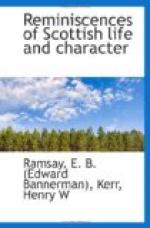That was the left side—the Crathes bank of Dee. Across the river was the somewhat dilapidated fortalice of Tilquhillie, the seat of an ancient and decayed branch of the Douglases. The last laird who dwelt there lived in the traditions of Deeside as own brother to the Laird of Ellangowan in Scott’s romance. Ramsay has put him well on canvas. Who does not remember his dying instructions to his son and his grieve?—“Be ye aye stickin’ in a tree, Johnny; it will be growin’ when ye are sleepin’!” while he cautions the grieve, “Now mind that black park; it never gied me onything, ne’er gie onything to it.”
In the days when the Dean knew that Water-side the fortalice was uninhabited, and I think not habitable for gentlefolks; but down on the haugh below, and close to the river in a pretty garden-cottage, dwelt the old Lady Tilquhillie, with her son the sheriff of the county, George Douglas, whom a few Edinburgh men may yet remember as the man of wit and pleasure about town, the beau of the Parliament House—at home a kind hospitable gentleman, looking down a little upon the rough humours that pleased his neighbours. The old lady—I think she was a Dutch woman, or from the Cape of Good Hope—and her old servant, Sandy M’Canch, furnished the Dean with many a bit of Deeside life and humour; and are they not written in the Reminiscences!
Higher up the river were two houses where the Dean was much beloved—Banchory Lodge, his uncle General Burnett’s, where also lived his dear aunt, the widowed Mrs. Forbes; and Blackhall, where, in the time I have in my mind, lived his aunt, Mrs. Russell, the widow of my uncle Francis Russell, a woman of many sorrows, but whose sweet voice and silver laugh brought joy into the house even amidst sickness and sorrow[8]. She had not the Deeside language, but she and her sister Lady Ramsay, Yorkshire women, and educated in the city of York, helped to give the Dean that curious northern English talk which he mixed pleasantly with the language of Angus and Mearns that he loved so well; and he inherited from the Bannermans the sweet voice, so valuable an inheritance to a preacher.




